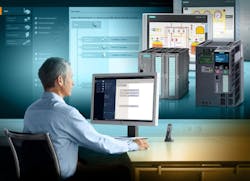The Siemens Industry Automation Division (www.automation.siemens.com) at a press conference at the SPS/Drives Trade Fair in Nuremberg, Germany, on Nov. 23 introduced new engineering development software with “One Engineering Environment” and “One Software Project” dubbed Totally Integrated Automation Portal (TIA Portal). The new software engineering framework enables users to develop and commission automation systems quickly and intuitively, which eliminates the traditional time-consuming and costly integration of separate software packages, said the German-based supplier. In the United States, Siemens Industry Inc. is headquartered in Alpharetta, Ga.
Designed for high efficiency and user-friendliness, the TIA Portal is suitable for both first-time users and experienced users. Further, the TIA Portal will be the basis of all future software engineering packages for configuring, programming and commissioning automation and drives products in the Totally Integrated Automation portfolio from Siemens. Applications released with the initial release include the new Simatic Step 7 V11 automation software for Simatic controllers, and Simatic WinCC V11 for Simatic HMI (human-machine interface) and process visualization applications.
The design makes use of one development environment, one unified database and a library of programming and visualization objects. The home screen is a clean, fresh interface that guides the developer through a series of choices for configuration using filtered responses to provide only the most relevant devices and instructions. A private demonstration provided for Automation World showed how easy the drag-and-drop paradigm is, including filtered suggestions for developers designing a new control scheme and visualization for machine builders and implementers. Right now, only programmable logic controller (PLC) programming and HMI are included, but variable frequency drives and motion are expected to join the family over the next couple of years.
Scalability
The new Simatic Step 7 V11 engineering software, based on the TIA Portal framework, supports Simatic S7-1200 controllers, all of the Simatic S7-300 and S7-400 controllers, and the personal computer (PC)-based automation system Simatic WinAC. Supporting this wide range of programmable controllers enables Simatic Step 7 V11 to provide a scalable software engineering capability and performance. Benefits of this scalability includes transferring existing configurations of Simatic controllers and HMI devices to new software projects, and greatly reducing the time and cost of typical software migration tasks.
About the Author
Gary Mintchell
Editor in Chief

Leaders relevant to this article:
